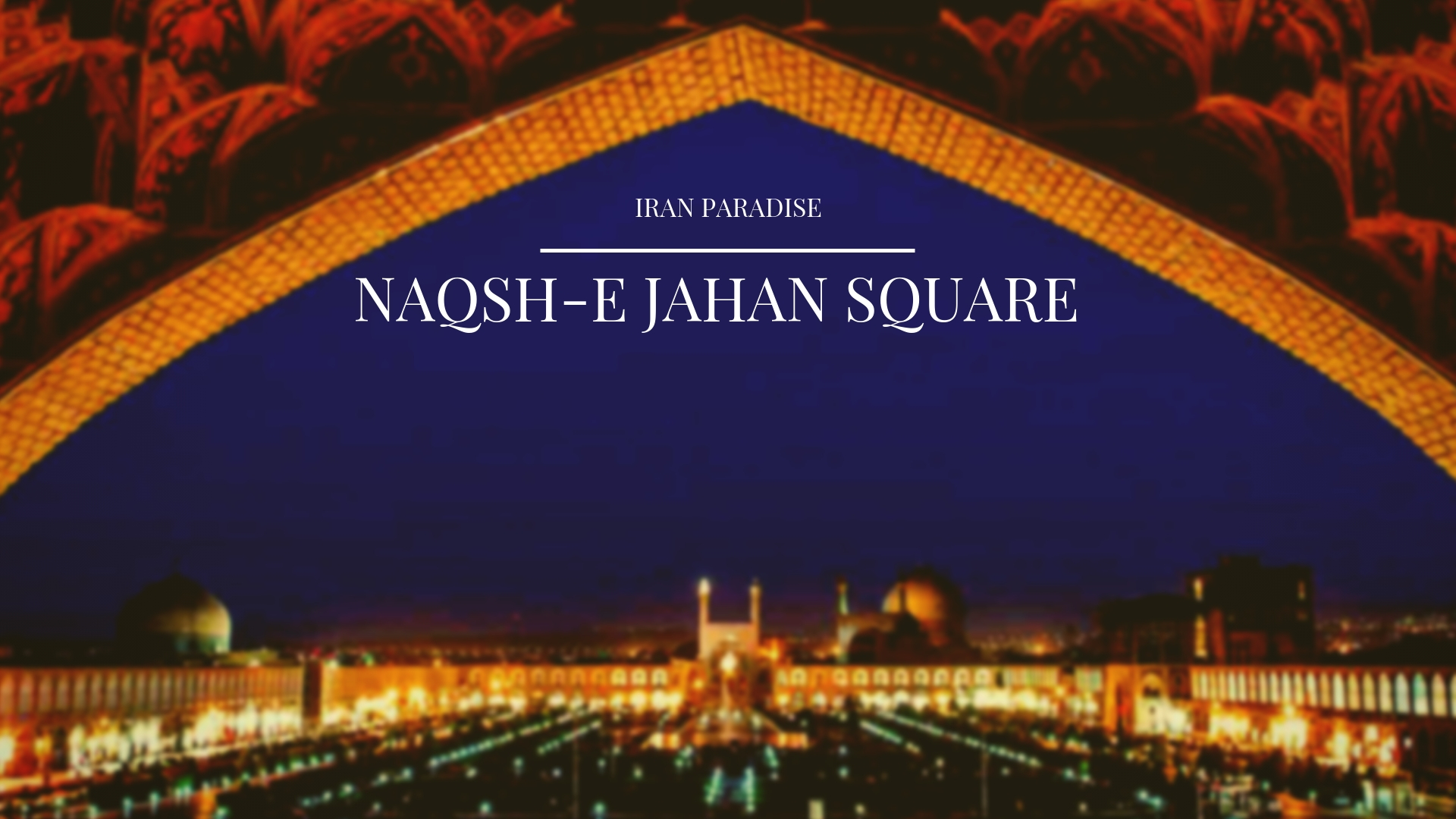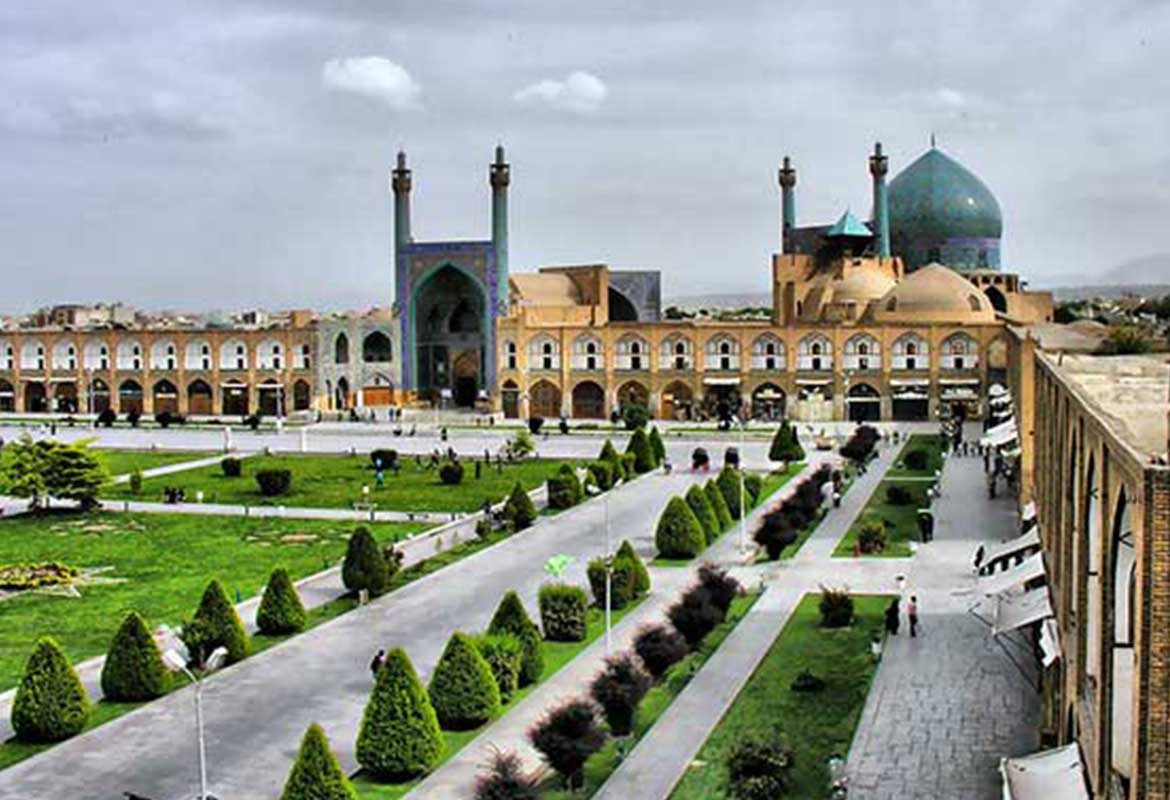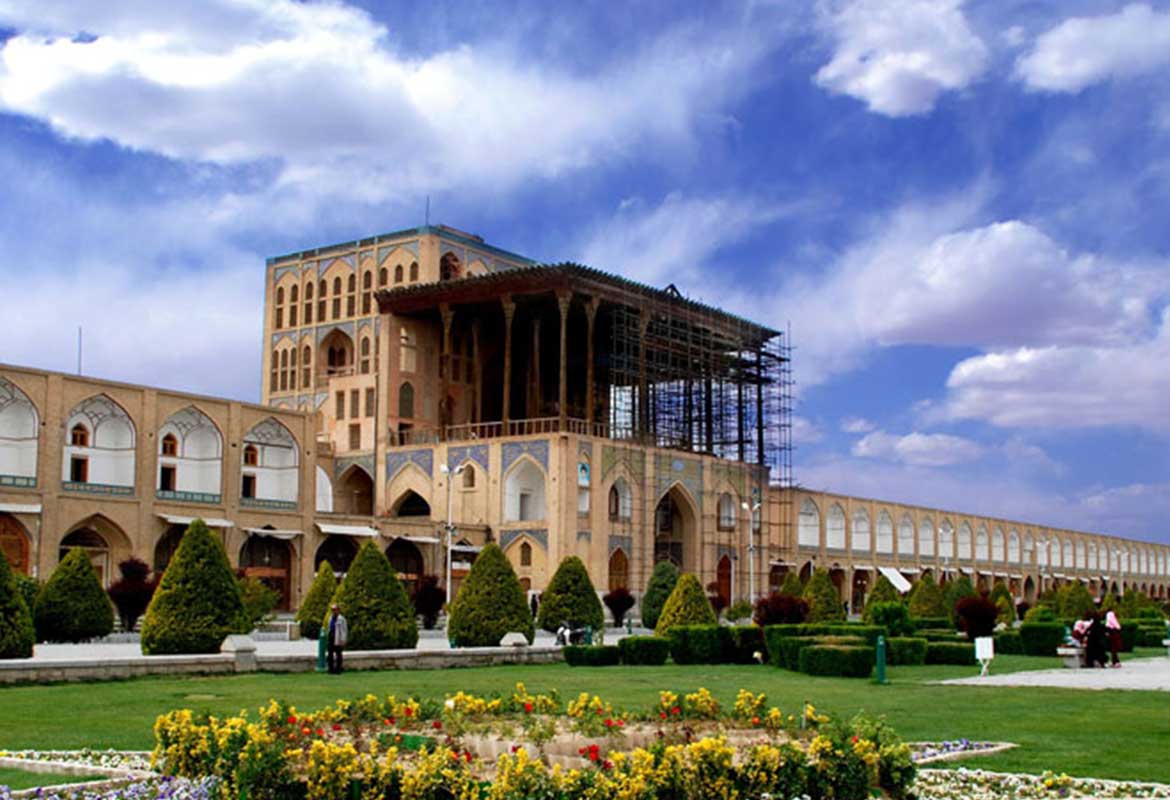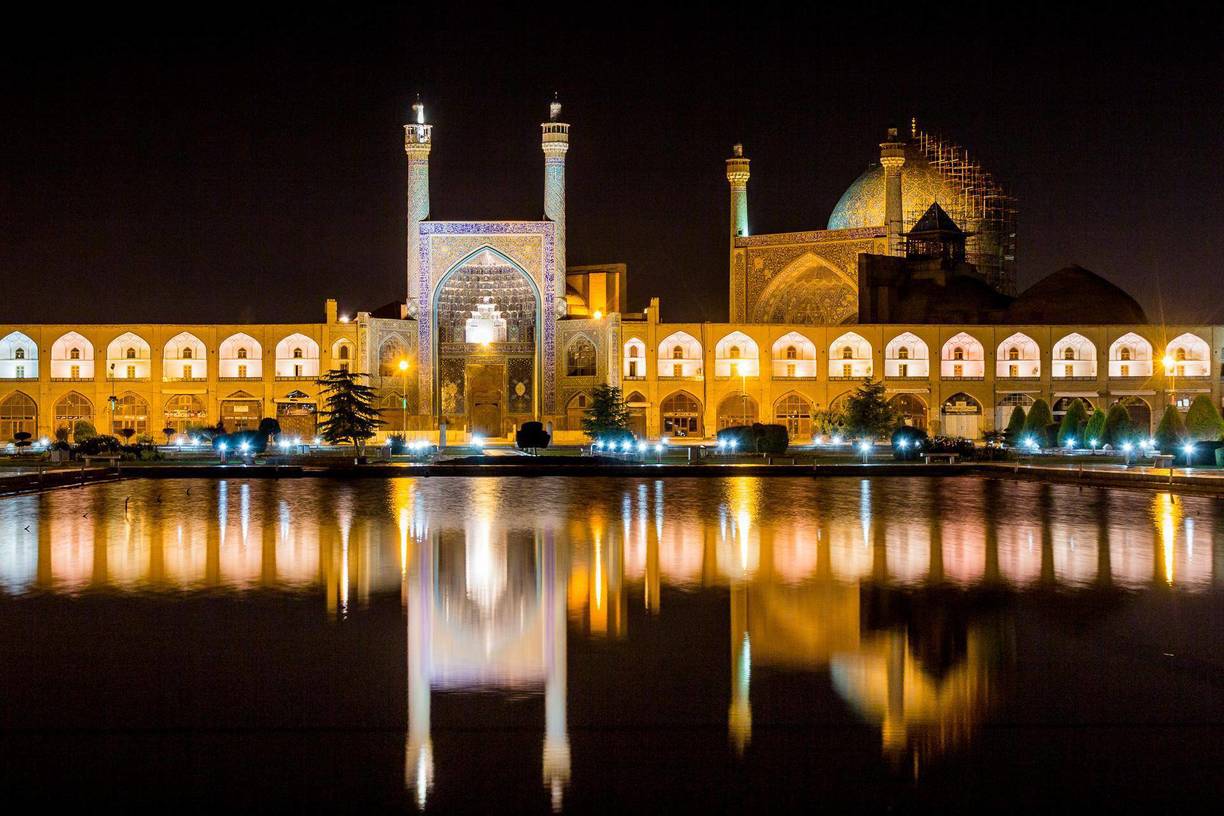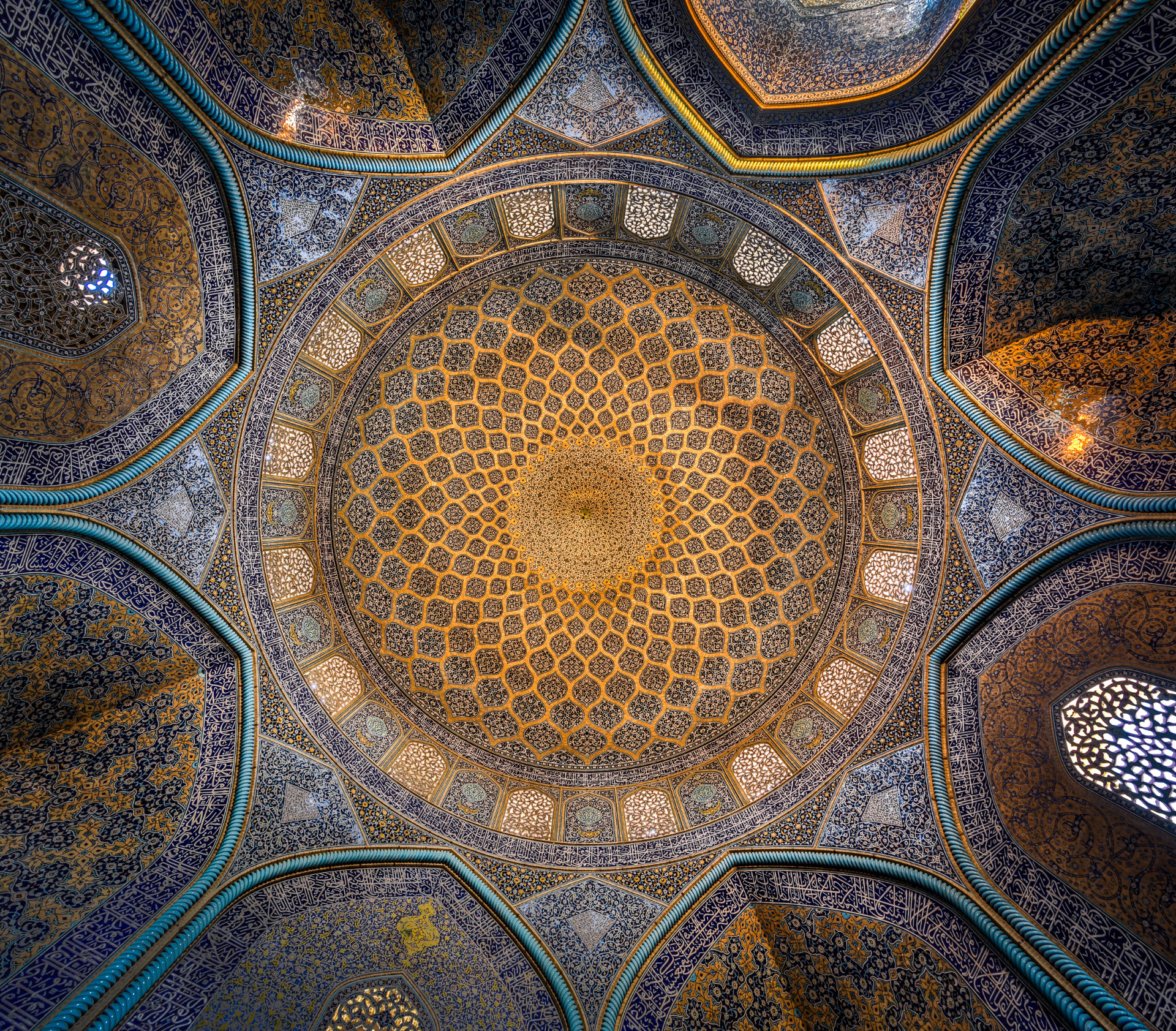Naqsh-e Jahan Square
Imam Mosque is a mosque standing in south side of Naqsh-e Jahan Square. Built during the Safavid period, an excellent example of Islamic Architecture in Persia (Iran). This mosque has been constructed during the Safavid period, in 1611 with seven-color mosaic tiles and valuable inscriptions. The portal of the mosque measuring 27 meters high, crowned with two minarets being 42 meters in height, frames the front of the mosque which opens into Naqsh-e Jahan square. On top of the entrance, among the stalactites and above the turquoise lattice window, there is a frame of seven-color mosaic tile shaped like a vase with two peacocks on both sides which is an example of mosaic tile. The inscription above the entrance being made of white mosaic tile on ultramarine background is written in Sols script by Alireza Abbasi.
The wooden door of the mosque, covered with layers of gold and silver, is ornamented with some poems written in Nasta’liq script. The overall entrance hall proves the mastery of the designer of the building. The master architect has designed two passageways being different in length on both sides of the hall to assimilate the axis of the mosque to the direction of kiblah which has an angle of 45 degrees, to cover the change of direction without losing the proportions.
The Mosque is surrounded with four ivans and arcades. All the walls are ornamented with seven-color mosaic tile. The ivan of the mosque is the one which is toward kiblah measuring 33 meters high and has two minarets being 48 meters high. Behind this ivan is a space which is roofed with the most enormous dome of the city being 52 meters high. The dome consists of two covers. The outer cover is 12 meters away from the inner one. There are two schools for religious education at the southwest and southeast of the mosque. The southwest school has an inscription from the Safavid period. There is also an indicator stone, inserted in the inscription, the shape of which is right-angled triangle. This stone shows the mid-day of all the days of the year scientifically in a simple way.
The mosque has two halls in the east and west part of its interior. The eastern hall is bigger but its walls are covered with plaster without any ornamentation while the walls and ceiling of the western hall are covered with seven-color mosaic tiles. The mihrab of this hall has an inscription written by the master artist, Mohammad Reza Emami.
Imam Mosque or Shah mosque, with blue-tiled mosaic designs and stunningly attractive and perfectly proportioned architecture of Safavid era creates a perfectly marvelous view to your eyes. This superb monument represents the creativity of Shah Abbas and the expertise of his architect. Construction of this masterpiece started in 1611 and terminated in 1629, the last year of Shah Abbas’s reign, when its high dome was finished. The white marble stones for its foundation were brought from the city of Ardestan and its portal is festooned with Kashi Moarraq by very skillful artists of that era. Its portal was constructed to face the square, but the mosque’s orientation is toward Mecca and the square is connected to the inner courtyard through a short corridor, having a pool for ritual ceremonies of absolution and four iwans. Its portal had an ornamental function in the beginning, but it changed to be the Qeysarieh Portal at the entrance of Grand Bazaar of Isfahan. The majesty of the architecture of this mosque cannot be described in words; thus you must go there to pay a visit in person.
Ali Qapu on the west side of Imam Square is Ali Qapu Palace, which is opposite to Sheikh Lotfollah Mosque, was fist constructed to be a huge portal. The monument with its six floors and forty-eight-meters of height has deep circular niches in the sixth floor. Its name means great gate because it was located exactly at the entrance to the Safavid palaces from Naqsh-e Jahan Square to the Chahar Baq Boulevard. The monument, built by the order of Shah Abbas I in the seventeenth century was originally constructed to receive foreign guests and ambassadors. Shah Abbas used to celebrate Nowrooz (Iranian New Year) here in this fabulous edifice.
Inside the monument is replete with naturalistic wall paintings of the court painter of Shah Abbas. There are flower, animal, and bird themes in his work. The last Safavid ruler, Shah Sulan Hussein, repaired and restored the whole monument, but again Afghans invaded Iran and made a mess of it. Shah Abbas II who was passionate for the embellishment and perfection of Ali Qapu, again restored it and added the third floor to its magnificent hall. 18 columns of this monumental edifice are decorated with mirrors and the ceiling is covered with great paintings. This palace is displayed on the back of the Iranian 20,000 Rials note.
Sheikh Lotf Allah Mosque is another monument dominating the boundary of the Naqsh-e Jahan Square, which was the first one among the four constructed edifices around the Square. This mosque, unlike Imam Mosque which was built for the public, was built for the private life of the royal court.At the entrance of the mosque, there were standing guards who protected the women of Shah, and the doors were held closed all the time. Although, in comparison with Imam Mosque, Sheikh Lotf Allah Mosque is very simple in design, but it has an exceedingly complex decoration both inside and outside. The exterior of its single 13 m in diameter dome is richly ornamented with exquisitely made and beautiful tiles.
Isfahan Bazaar, or Bazaar of Isfahan, a historical market in Isfahan, is one of the oldest and largest bazaars in the Middle East, originated in the 17th century. The bazaar is a two-kilometer vaulted street connecting Isfahan’s old city to its new city. The grand bazaar of Isfahan was itself a complete covered town around which the old Isfahan City was concentrated. There are caravanserais in the bazaar with a rectangular shaped open courthouse.
Every line of the bazaar is allocated to selling certain types of goods, such as carpet, shoes, spices, gold, silver, handicrafts.Handicrafts is one of the most interesting parts of your trip will definitely be a surprise to you. You can enjoy different kinds of handicrafts such as the world-famous colorful Iranian hand woven rugs or carpets of this country, Moarraq Kari, a sort of delicate manual wood working, Khatam Kari, the art of decorating the surfaces of wooden articles with fine pieces of wood, bone and metal precisely cut geometrical shapes. you can also buy Sohan, a kind of sweet traditional Persian saffron brittle toffee made of flour, egg yolks, rose water, sugar, butter, or vegetable oil, saffron, cardamom and pieces of almond or pistachio. You can also find different kinds of Iranian spices with various flavors from hot to strange to make your food or dish tasty.
Tags:Ali Qapu Palace, Alireza Abbasi, arcades, Ardestan, caravanserais, Chahar Baq Boulevard, Imam Mosque, Imam Square, Iranian New Year, ivans, Kashi Moarraq, mihrab, Mohammad Reza Emami, Naqsh-e Jahan Square, Nasta'liq script, Nowrooz, Qeysarieh Portal, Safavid period, seven-color mosaic, seven-color mosaic tile, Shah mosque, Shah Sulan Hussein, Sheikh Lotfollah Mosque


